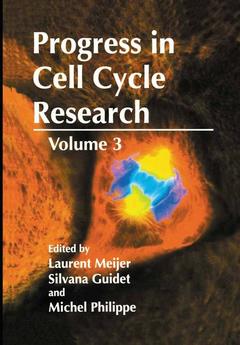Description
Progress in Cell Cycle Research, 1997
Volume 3
Progress in Cell Cycle Research Series
Coordinators: Meijer Laurent, Guidet Silvana, Philippe Michel
Language: English
Subjects for Progress in Cell Cycle Research:
Publication date: 10-2012
321 p. · 17.8x25.4 cm · Paperback
321 p. · 17.8x25.4 cm · Paperback
Description
/li>Contents
/li>
The "Progress in Cell Cycle Research" series has been conceived to serve as a collection of reviews on various aspects of a fast growing biology field, the cell division cycle. These reviews do not pretend to cover all aspects of cell cycle regulation and mechanisms but rather focus on a few topics of particular interest in the recent literature. This third volume starts with a broad overview of the diversity of ways by which viruses subdue their host cell cycle (chapter 1). Of particular interest in this area is the case of HN which has recently been extensively investigated (chapter 2). Although most of our understanding of cell cycle regulation derives from work performed in yeast and animal cells, plant models, reviewed in chapter 3 for one of the best studied example, Arabidopsis, are starting to contribute significantly to the cell cycle general picture. In mammals, the regulation of cell division of two types of tissues, the intestine (chapter 4) and the developing muscle (chapter 5) are investigated in an interesting physiological context. Cell division is accompanied by a number of morphological changes. One of them, organelle transport, is starting to be better understood (chapter 6). The next few chapter summarise our knowledge of some essential regulators of the cell cycle. A still intriguing enzyme, casein kinase 2, is reviewed in detail in chapter 7. Some of the most studied cell cycle regulators are certainly the CKI's, cyclin-dependent kinases inhibitors (chapter 8).
Viruses and the cell cycle.- HIV-1 Vpr: G2 cell cycle arrest, macrophages and nuclear transport.- Regulation of cell division in plants: an Arabidopsis perspective.- Intestinal cell cycle regulation.- Coordinate regulation of cell cycle and apoptosis during myogenesis.- Cell cycle regulation of organelle transport.- Protein kinase CK2 (“casein kinase-2”) and its implication in cell division and proliferation.- The regulation of cyclin-dependent kinase inhibitors (CKIs).- Contribution of the dual coding capacity of the p16INK4a/MTS1/CDKN2 locus to human malignancies.- p21: structure and functions associated with cyclin-CDK binding.- The cdcl8 protein initiates DNA replication in fission yeast.- Cell cycle regulation of S phase entry in Saccharomyces cerevisiae.- pRB, pl07 and pl30 as transcriptional regulators: role in cell growth and differentiation.- The role of cyclin E in cell proliferation, development and cancer.- Multiple roles of the proliferating cell nuclear antigen: DNA replication, repair and cell cycle control.- Aberrations of the G1- and G1/S-regulating genes in human cancer.- Regulation of p34cdc2/cyclin B H1 and NIMA kinases during the G2/M transition and checkpoint responses in Aspergillus nidulans.- Myt1: a Wee1-type kinase that phosphorylates Cdc2 on residue Thr14.- In vivo regulation at the entry into M-phase: initial activation and nuclear translocation of cyclin B/Cdc2.- Mos and the cell cycle.- Calcium and mitosis.- Role of chromosomes in assembly of meiotic and mitotic spindles.- Organisation and functional regulation of the centrosome in animal cells.- Mitosis and checkpoints that control progression through mitosis in vertebrate somatic cells.- Contributors.
© 2024 LAVOISIER S.A.S.
These books may interest you

Advances in Cancer Research 135.60 €



